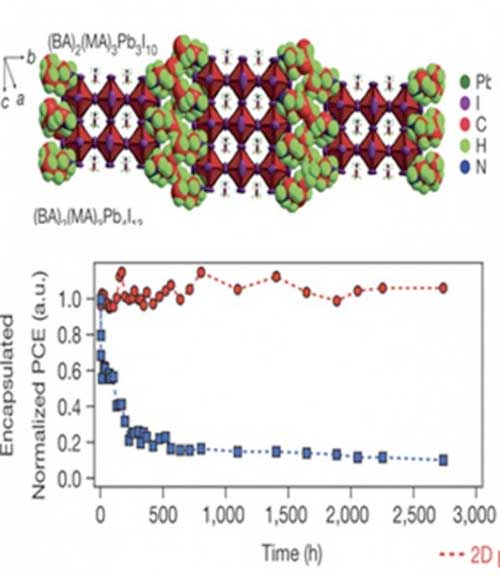| Posted: Aug 30, 2017 |
The tricky trifecta of solar cells
(Nanowerk News) Layering thin sheets of two-dimensional (2-D) perovskite materials creates a promisingly stable solar cell. However, the cell is not as efficient as its thicker, less stable three-dimensional (3-D) counterpart.
|
|
Scientists overcame the inefficiency of 2-D perovskite solar cells without sacrificing stability. They did so by redesigning the cell so that the perovskite sheets were preferentially oriented perpendicular to the substrate, like books on a bookshelf (Science, "Extremely efficient internal exciton dissociation through edge states in layered 2D perovskites").
|
 |
| Crystal structure of a three-layer Ruddlesden-Popper two-dimensional perovskite (top). Time-dependent (hours) power conversion efficiency (PCE) of encapsulated 2-D and 3-D perovskite planar solar cells under constant illumination (bottom). (Image: Mercouri Kanatzidis and Aditya Mohite)
|
|
These new materials may enable the “trifecta” of solar cell properties: inexpensive, stable and efficient. They are inexpensive because they are solution synthesized. They are stable on technologically relevant time scales. They are efficient with as high as 12.5 percent power conversion efficiency.
|
|
Three-dimensional (3-D) organic–inorganic perovskites have emerged as one of the most promising thin-film solar cell materials owing to a dramatic increase in their efficiencies in just a few short years, combined with their compatibility with inexpensive synthesis methods.
|
|
A major challenge, however, has been a property just as critical: environmental and photo stability under operating conditions. As one possible solution, scientists have been studying Ruddlesden-Popper phases: layered two-dimensional (2-D) counterparts to the 3-D perovskites.
|
|
These 2-D perovskite films have previously shown promising stability, but relatively poor photovoltaic efficiency (4.73 percent). The scientists attribute the low efficiency to inhibition of out-of-plane charge transport by organic cations, which act like insulating spacing layers between conducting inorganic slabs.
|
|
A research team overcame this poor efficiency by synthesizing thin films of near-single-crystalline quality, in which the crystallographic planes of the inorganic perovskite component are preferentially out-of-plane aligned with respect to the electrical contacts, thus facilitating charge transport.
|
|
Photovoltaics based on these 2-D perovskite films exhibit an efficiency of 12.52 percent and, when encapsulated, do not degrade under constant simulated solar illumination and humidity for weeks.
|

